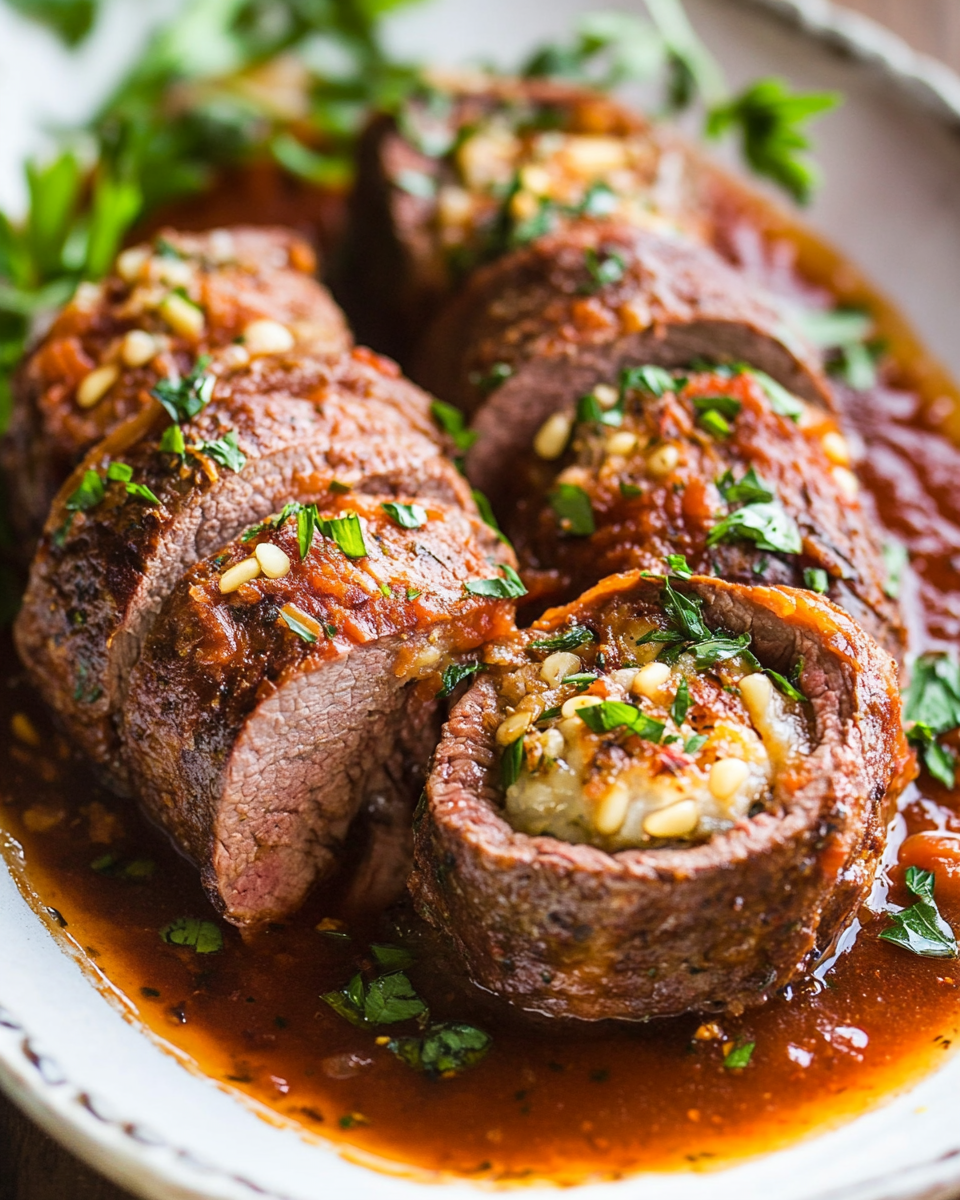The Italian Beef Braciole is a time-honored dish that captures the heart of traditional Southern Italian cuisine. Thin slices of beef are wrapped around a flavorful stuffing of breadcrumbs, cheese, garlic, and herbs, then gently braised in a rich tomato sauce until they become fork-tender. Each bite carries the depth of slow cooking and the comfort of a family recipe passed down through generations. This dish is ideal for hearty dinners or festive family gatherings. It pairs wonderfully with pasta, mashed potatoes, or creamy polenta, soaking up every drop of the luscious sauce. Braciole is not just a meal it’s an experience of Italian warmth and tradition in every bite.
Full Recipe:
Ingredients:
-
6 thin slices of top round beef (about ¼ inch thick)
-
1/2 cup Italian seasoned breadcrumbs
-
1/3 cup grated Pecorino Romano cheese
-
2 cloves garlic, minced
-
1/4 cup fresh parsley, chopped
-
2 tablespoons pine nuts (optional)
-
Salt and freshly ground black pepper
-
Kitchen twine or toothpicks for securing
-
2 tablespoons olive oil
-
1/2 cup dry red wine
-
1 large can (28 oz) crushed tomatoes
-
1 small onion, finely chopped
-
1 bay leaf
Directions:
-
Lay the beef slices flat on a cutting board. Pound gently to an even ¼ inch thickness if needed.
-
In a small bowl, combine breadcrumbs, grated cheese, garlic, parsley, and pine nuts. Season with a pinch of salt and pepper.
-
Spoon a small amount of the filling mixture onto each beef slice, spreading evenly. Roll up tightly and secure with kitchen twine or toothpicks.
-
Heat olive oil in a large Dutch oven over medium heat. Brown the beef rolls on all sides, working in batches if necessary. Remove and set aside.
-
In the same pot, add chopped onion and sauté until translucent. Deglaze with red wine, scraping up any browned bits from the bottom.
-
Add the crushed tomatoes and bay leaf. Return the beef rolls to the pot and spoon some sauce over the top.
-
Cover and simmer on low heat for 1.5 to 2 hours, or until the meat is tender and the flavors are melded. Stir occasionally to prevent sticking.
-
Remove bay leaf before serving. Serve hot with extra sauce over pasta or creamy polenta.
Prep Time: 20 minutes | Cooking Time: 2 hours | Total Time: 2 hours 20 minutes
Kcal: 375 kcal | Servings: 4 servings
The Timeless Charm of Italian Braciole: Stuffed Beef Rolls in Rich Tomato Sauce
Italian cuisine is globally celebrated for its rich heritage, comforting flavors, and culinary traditions passed down through generations. One of the dishes that perfectly embodies this spirit is Braciole, a classic Southern Italian preparation featuring thin slices of beef stuffed with a savory filling and slowly simmered in a vibrant tomato sauce. While each Italian region and even each family may have its own variation, the essence of Braciole lies in its celebration of simple, wholesome ingredients and slow-cooked flavor.
Whether served on a cozy Sunday dinner table or during festive holiday meals, Braciole brings a sense of warmth, nostalgia, and satisfaction that is difficult to match. In this article, we will explore the history, cultural significance, variations, serving suggestions, and enduring popularity of this Italian favorite.
Origins and History of Braciole
Braciole (pronounced brah-CHO-lay or brah-ZHO-lay, depending on the dialect) hails from Southern Italy, particularly regions like Campania, Sicily, and Calabria. Historically, the dish was considered a way to make the most of more affordable cuts of meat. By pounding the beef thin and rolling it with a flavorful filling of breadcrumbs, cheese, and herbs, cooks were able to transform inexpensive ingredients into a luxurious and tender main course.
The name “Braciole” originally referred to simple grilled or pan-fried slices of meat. However, over time, the term evolved to include the version that’s now more commonly recognized: beef rolls stuffed and braised in sauce. The stuffed-and-braised Braciole that we know today likely evolved as a Sunday or celebratory dish, cooked low and slow alongside other meats in a large pot of tomato sauce, known as “Sunday gravy.”
A Celebration of Ingredients
What makes Braciole exceptional is the way it harmonizes humble ingredients into something deeply flavorful and satisfying. Traditionally made with top round or flank steak, the meat is pounded thin and filled with a mixture that typically includes Italian seasoned breadcrumbs, grated hard cheeses such as Pecorino Romano or Parmesan, minced garlic, fresh parsley, and sometimes pine nuts or raisins for sweetness and texture.
Once filled and tightly rolled, the beef is seared to lock in flavor and then simmered for hours in a homemade tomato sauce. This slow cooking process transforms the meat into a fork-tender delicacy while also enriching the sauce with the savory essence of the beef and its filling. The final dish is typically served with pasta, polenta, or rustic bread anything that can soak up that beautifully flavorful sauce.
Regional and Family Variations
One of the most beautiful aspects of Braciole is the diversity it offers. There’s no single “correct” way to prepare it rather, the recipe reflects the regional and familial nuances that make Italian cuisine so dynamic.
In some parts of Italy, pork or veal is used instead of beef. In Sicily, it’s not uncommon to find versions that include raisins or even hard-boiled eggs inside the filling, a nod to the island’s unique blend of sweet and savory flavor traditions. Other regions might add prosciutto, mortadella, or even provolone cheese inside the roll.
The sauce too varies some use crushed San Marzano tomatoes, others include a splash of red wine or a handful of fresh basil. These variations make Braciole a dish that’s never quite the same twice, and yet always familiar and comforting.
A Dish Rooted in Family Traditions
Braciole is more than just food it’s an experience steeped in family, tradition, and memory. For many Italian-American families, Braciole is a staple of Sunday dinners, nestled in pots of simmering sauce alongside meatballs and sausage. It’s the kind of dish that children remember their grandparents preparing, that makes its way to the holiday table year after year.
Preparing Braciole often involves an element of ritual. The pounding of the meat, the careful rolling and tying with kitchen twine, the slow simmering it’s a process that invites participation and patience. Many home cooks recall standing by the stove, watching the sauce bubble and waiting for that moment when the aroma fills the kitchen, signaling that dinner is almost ready.
Ideal Pairings and Serving Suggestions
Braciole is a rich, hearty dish that pairs beautifully with a variety of sides. The most traditional accompaniment is pasta especially long, ridged varieties like rigatoni or bucatini that cling to the sauce. Polenta is another excellent pairing, offering a creamy base that soaks up every drop of the flavorful tomato braise.
For a complete Italian feast, serve Braciole with a fresh green salad, crusty bread, and a glass of bold red wine Chianti, Sangiovese, or Montepulciano d’Abruzzo are excellent choices. Leftovers are even better the next day, as the flavors continue to meld and intensify.
You can also prepare Braciole in advance, making it a great choice for dinner parties or family meals where you want to spend more time at the table and less in the kitchen.
Why Braciole Remains a Beloved Classic
Despite its old-world origins, Braciole continues to find a place in modern kitchens for several reasons. First, it’s incredibly flavorful. The combination of tender beef, garlicky cheese filling, and robust tomato sauce is irresistible. Second, it’s versatile. The recipe can be adapted to different dietary preferences, budgets, and available ingredients.
But perhaps most importantly, Braciole represents something deeper: a connection to heritage, to the idea that food is not just nourishment but a way of expressing love, culture, and memory. In an age of quick meals and fast food, Braciole reminds us of the value of slowing down and cooking with intention.
Conclusion:
If you’ve never tried making Braciole at home, it might seem intimidating at first glance. But once you’ve done it, you’ll find that it’s a deeply rewarding experience both in the process and the result. Rolling each piece of beef, letting it simmer in the rich sauce, and finally sharing it with loved ones around the table creates a feeling of satisfaction that’s hard to match.
Braciole is more than just a recipe it’s a symbol of Italian culinary artistry, the kind of food that tells a story with every bite. Whether you’re reviving a family tradition or discovering this dish for the first time, Braciole is sure to become a treasured part of your cooking repertoire.
Make it for a Sunday supper, a special occasion, or simply because you crave something comforting and timeless. With every forkful of tender, stuffed beef bathed in sauce, you’ll taste the magic that makes Braciole a beloved Italian classic.






